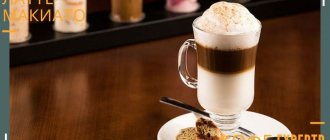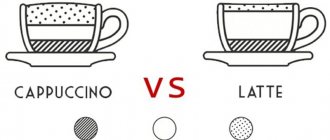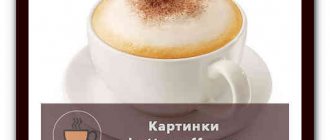The Russian language contains many words that are foreign in origin. The reason for this is that the objects they represent originally appeared in foreign-language societies and came to us with their own name. In our country they often continue to be called the same. However, the graphic form of borrowed words and their correct spelling can cause serious difficulties and discrepancies. For example, cappuccino. After all, many people love this drink for its soft and velvety taste. However, not everyone will be able to write its name correctly. So what is correct: “cappuccino”, “cappuccino” or “cappuccino”?
Correct spelling
If you want to know how to spell a particular word correctly, you should consult a spelling dictionary or a dictionary of foreign words. However, you should not rely solely on the opinion of Wikipedia.
Dictionaries published in the last century do not yet list this word for obvious reasons - after all, the drink itself became widespread in Russia only in its last years. Dictionary of foreign words N.G. Komleva cites the spelling of “cappuccino”. However, the “Russian Spelling Dictionary”, edited by V.V. Lopatina gives something else - “cappuccino”. So why do even dictionaries give different options?
The fact is that the spellings of foreign words, having entered the Russian language, begin life in it in the form of tracing paper, that is, they repeat the original form in Cyrillic. Gradually they assimilate, and the spelling begins to correspond to the norms of the Russian language, one of which is to display the word on paper as close as possible to its phonetic form, that is, to how it is pronounced.
Now, if you pay attention to the release dates of the above dictionaries, you will find that Komlev’s dictionary was released in 2006, and Lopatin’s spelling dictionary – in 2021.
The version given in the later edition should be considered correct. That is, “cappuccino”. And this is logical - after all, today no one, speaking about a drink in Russian, doubles any of the consonants - neither “p” nor “ch”.
When knowledge of the etymology of a word fails
The drink, whose name is confusing, comes from Italy. The word “cappuccino” appeared in the Italian language in the 20th century, it means coffee with frothed milk and is related to the word “hood”, because cappuccino is coffee with a cap (hood) of foam.
- Don't miss: How to make cappuccino correctly
In 1901, Italian Luigi Bezzera invented a mechanism for making espresso and a device for frothing milk with hot steam. The coffee drink topped with airy milk foam is called “cappuccino”. In this form the word spread throughout the world. In Italian, as in English, the correct way to write it is with double “pp” and “cc” – “cappuccino”. In the Russian language environment, the new borrowed word did not immediately take root. In dictionaries from different years of release you can find all sorts of spellings: cappuccino, cappuccino, cappuccino (found in literature for baristas) and cappuccino.
In a literary language, it is correct to use “cappuccino” without doubled consonants. This norm is recorded in the “Russian Spelling Dictionary” of the Russian Academy of Sciences, edited by V.V. Lopatin, version 2005. Today the norm has been established, and there is no longer any doubt whether it is correct to write “cappuccino” or “cappuccino”. The only correct spelling in the modern Russian literary language is “cappuccino”.
History of the word
The birthplace of the name, as well as the drink, is Italy, and there the word is written as follows - “cappuccino”. According to one version, it was invented by the monks of the Capuchin Order. Since drinking coffee did not correspond to the ascetic life of the members of the order, they came up with the idea of mixing it with milk.
The second version of the origin of the name is also associated with this order. The color of the finished drink is very similar to the clothes of monks - brown below, white above.
There is a third explanation - the word “cappuccio” translated from Italian means “hood”. After all, this object looks like a cap of frothed milk rising above a cup of coffee. By the way, the name of the monastic order, whose members wore pointed hoods, also came from this word. And the family of capuchin monkeys also owes its name to the hood of hair on the top of the head of each of its representatives.
How to spell
The history of the origin and name of the drink goes back to Italy. There is even a legend that it was prepared at the Capuchin monastery, hence the name. Monks wear long white hoods, and robes were usually light brown, which is why the designation of this word is translated as “hood.”
In the Middle Ages, coffee was considered the drink of Satan for the reason that drinking gave vigor and caused addiction. It is for this reason that they began to add milk and milk foam to it.
So which is correct: cappuccino or cappuccino? In English and Italian, double spellings are used with the letters “P” and “C”.
If coffee is written in Russian, most often, double letters are not used. However, even at this point everything is not clear; sometimes their use is still acceptable.
The spelling of foreign words is fixed in the spelling dictionary, but in the literature it is denoted with one letter, a professional barista uses it with two letters, and Wikipedia and other sites on the Internet say that both of the presented options are correct. The stress falls on the penultimate syllable of I.
Cappuccino translation, gender
One of the significant questions is what type of coffee - masculine or average. This question arose often in variations of coffee: is it he or it. At first glance, you might think that the word is neuter, but in fact, drinking with milk foam, like “Coffee,” is masculine.
What kind: masculine or neuter?
For many years there has been debate about whether the word “coffee” is “he” or “it.” It is perceived by ear as “it,” which is why many people use it that way: “The coffee is too strong,” “The latte is a little hot.” According to the rules of the Russian language, the name of the invigorating drink is written and pronounced as a masculine gender, that is, “he”.
It must be said that the contradictions began with the fact that previously words borrowed from foreign languages that ended with the vowel “e” were used as neuter nouns. However, in fiction, “coffee” was written as “he.” The fact is that in those days when the drink first appeared in Russia, it was called exclusively “coffee” or “coffee”. This went on for quite a long time, and only after many years the word began to be written and pronounced in the format familiar to us.
But not all Russian writers used the masculine gender; many continued to use the neuter gender: delicious coffee.
In 2002, the Ministry of Education of the Russian Federation made significant adjustments to the controversial issue. Now the word “coffee” is allowed to be used in both the masculine and neuter gender. It is worth noting that the last option is only appropriate in colloquial speech. It is strongly recommended to write “coffee” in the masculine gender. If a word is used to name a tree on which beans grow, it is said and written - “it”.
In foreign languages, “cappuccino” has only the neuter gender. In Russian, two variants are allowed:
- delicious cappuccino, sweet latte;
- delicious cappuccino, sweet latte.
In contrast to the strict rules regarding the word "coffee", nouns that refer to milk drinks are also allowed to be pronounced and written in the neuter gender.
Cappuccino: history
The coffee drink cappuccino begins its history back in the 16th century, when in a small monastery near Rome, Capuchin monks began adding milk and foam to their coffee. It's not hard to guess where the name came from. In the Middle Ages, cappuccino was considered the drink of the devil, as it gave vigor and was somewhat addictive. To “cleanse” and in order to somehow soften the pressure of dogma, milk and milk foam began to be added to coffee. Another interesting fact from the history of cappuccino: the color of the robes of the Capuchin monks was close to light brown, and the color of the hoods was close to white. Doesn't remind you of anything?
Gift from Italy
And if you look at the homeland of an amazing coffee drink with a lush cap of milk foam? The land of the most passionate people in the world will clearly indicate: it or he! Due to the ending in “-o”, cappuccino corresponds to the masculine gender. Hot and aromatic coffee will transport your consciousness to a world of bliss.
However, the latest editions of Russian language dictionaries allow the word to be used in the neuter gender. Why? The structure of the language and age-old laws literally force citizens to subconsciously use it this way. A similar situation with a possible “sex change” has arisen with other cooking methods:
- latte;
- look;
- espresso.
Only for Americano dictionaries have not yet recorded any norm. Or are there options?
Word migration
Within the framework of one culture it is impossible to give names to all objects in the world. Some terms seem more cumbersome compared to foreign analogues, others cannot give a complete picture of the thing, and sometimes there is simply no suitable definition in the language. Ask your grandmother as often as you like: “Cappuccino – he or it?” How to spell the mystery word correctly? She most likely doesn’t know because she’s hearing it for the first time and associates it with some Italian composer.
As they are borrowed, proper names become untied from specific brands and turn into common nouns. They may adapt to the demands of their “new” language or experience severe delays in morphological adaptation. That is, they do not accept the new rules!
At the household level
What's the result? Cappuccino is “he”! Or “it”, as you wish. Feel free to place any order:
- One cup of cappuccino.
- One cappuccino.
- One cappuccino.
Linguists will not have the slightest complaint against you. However, to this day there are people who are intolerant of new trends. They believe that in most situations it is appropriate to refer to the masculine gender. And this is easy to justify with a chain of interrelated and dependent terms:
- cappuccino – “he” in Italian;
- this is coffee - and therefore also “he”;
- the drink is invariably courageous.
You can get around the awkward plural situation and order just a few at a time. Two or three cappuccinos are identical for "he" and "it". Want more? No problem, they come to the rescue:
- glasses;
- cups;
- portions.
In this case, the question (“Bring what?”) is asked to the vessel, and the gender of the numerals with pronouns correlates with the gender of the container itself. Very convenient if you can’t remember the rules or are shy around others:
- Make one glass of Americano.
- Bring a cup of espresso.
- I’ll have a large portion of latte, and my friend will have a small portion of ice.
A small trick, but it makes life so much easier!
Examples of use in sentences
The correct spelling of the name of the coffee drink can be found in a spelling dictionary. To understand how best to use words in Russian, here are some simple examples:
- The cafe makes incredibly delicious cappuccino coffee.
- We invite you to try an amazing cappuccino with the addition of citrus syrup.
- The cappuccino turned out sweet.
- A cup of aromatic cappuccino and a muffin is my breakfast.
It is better to avoid the following spellings:
- I really love a hot cappuccino with fresh rolls.
- Today you will find a promotion: “One cappuccino free if you order two espressos.”
Cappuccino is a favorite coffee and milk drink in many countries. Of course, the correct spelling will not make the amazing taste worse. But we all want to be literate and know how to write and pronounce words in Russian. Let us remind you once again: cappuccino is written this way, despite the fact that in foreign languages the name “cappuccino” uses double consonants “p”, “s”.
Glasse or glasse
There is a lot of information on the Internet regarding the correct spelling of this French word. Glace (glace) is translated as “frozen” . As with most words of French origin, the emphasis in it is on the last syllable - glace. There is a version that this wonderful drink, consisting of coffee and ice cream, was invented in Austria.
According to the latest, most complete edition of the spelling dictionary, the correct spelling of this word is considered to be glace, with one letter “s”. The Wikipedia dictionary provides slightly different information. Various forms of writing are allowed there: both glasse and glace.
It is important to remember here that in the original the word glace is written and pronounced as glace, i.e. with one letter “s” . Therefore, it passed into the Russian language unchanged.
All the most interesting iced coffee recipes are collected here.
Correct spelling of cappuccino
When we pronounce some words, we do not think about their correct spelling. So it is with the name of an espresso-based coffee drink - not everyone knows how to spell cappuccino, although many drink it. This word was borrowed from Italian, so it is not surprising that certain difficulties may arise when writing it, since it is not native to the Russian language.
There are many legends surrounding this drink about its origin. Most of them are still inclined to believe that this type of coffee comes from Italy and is named after the monks of the Capuchin Order, who allegedly came up with such a recipe.
The robes of the monks were very symbolic - dark brown robes and a light long hood. However, the word itself in Italian means this item of clothing. How did the monks come up with this recipe?
According to legend, the Catholic Church was against coffee, considering it the devil's drink, for its tonic properties, black color, and the addictive nature it caused. That's why the monks took this tricky step of adding milk to lighten the color and make it less strong.
So how do you spell cappuccino? Are there double letters, such as cappuccino or cappuccino? In English-speaking countries, the letters “p” and “h” are doubled. In Russian, doubling is often not used. Although it's hard to say for sure.
According to the spelling dictionary, the name of this drink is spelled with one "p", professional baristas use doubling, and Wikipedia claims that both spellings are absolutely correct. But in terms of stress, everyone agrees on one option - it falls on the last syllable, on the letter “and”.
In English, the word "cappuccino" is neuter. Only in Russian, the name of this variant of coffee is masculine, similar to the word “coffee”.
We figured out the writing. Often doubling is not applied. This is most likely due to the fact that doubling letters such as “p” and “ch” is not typical for the Russian language, and this looks like a mistake.
What is the correct spelling: cappuccino, cappuccino or cappuccino?
The milkshake and coffee came to us from ancient times and is of Italian origin. Already in the 16th century, members of the ancient monastic order of the Capuchins added milk to black coffee. According to legend, the drink got its name precisely because of the clothes of the monks: in those days they wore brown robes and pointed snow-white hoods.
Translated from Italian, cappuccino means “hood.”
In the Middle Ages, coffee was banned. It was believed that the invigorating drink was a work of the devil, so it was decided to add dairy products to it to make the taste lighter.
How to spell the word "cappuccino"? Italians use double letters "p", "c". If a word needs to be written in English, it is done this way: “cappuccino”. In the Russian interpretation of the name of coffee, as a rule, the letters “p” and “ch” are used without repetition. But, as in many names that come to us from foreign languages, there may be exceptions, and sometimes repeated consonants are allowed to be written.
The spelling dictionary says that “cappuccino” is correctly written without the double letters “p” and “ch”. Coffee professionals prefer to use the double spelling: “cappuccino,” and Internet portals say that both options can be used.
Why did they decide to write “cappuccino” in Russian without double consonants, as is done in foreign languages? Perhaps a variation in translation from Italian or English is to blame. We are more accustomed to seeing one letter “p” and “h”. If you write the word “cappuccino”, it will definitely raise a number of doubts, because it looks somehow unnatural. However, this does not prevent many from using this option, despite the rules of the Russian language.
Is the word inflected by case?
To understand how to correctly spell the name of the drink “cappuccino”, it is important to know what gender it is and whether it is declined according to cases.
In singular and plural, "cappuccino" remains the same in all cases:
- nominative;
- genitive;
- dative;
- accusative;
- creative;
- prepositional











